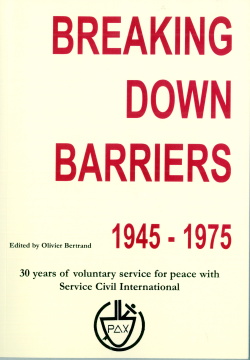An overview of SCI development after the war
Until World-War II and for some time afterwards, SCI was a purely European organization, despite its international aspirations. Volunteers and branches were European and the International Secretariat was in Europe. In view of the position of this continent in the world at that time, this situation could seem quite natural. Therefore, there is some justification to include in the same chapter the memories of volunteers who participated in workcamps in Europe and of those (usually the same) who contributed to the establishment of an international structure as leaders and staff members.
The development of workcamps and particularly of SCI has always been affected by the historical context. During the war, surprisingly, there were many projects and the number of young people involved was hardly decreasing. But this covered very different types of workcamps, none of them international, and inspired by contrasting ideologies. Some of them were sponsored by governments in countries defeated and occupied by the Nazis; they had a highly nationalist and sometimes almost fascist inspiration. On the opposite side, the British Government having allowed conscientious objectors to participate in civilian activities for the defence of the country, a number of them worked in such programmes. The British branch of SCI was involved in them.
Apart from these, in a context of conflict and of travel limitations, SCI activities were reduced to a minimum. According to Ralph Hegnauer, nothing was left of the old SCI at the end of the war, except for a few former activists in Switzerland.
If then we look at the post-war period primarily from a European perspective (specific features of the context in other continents will be described in the following chapters), five major trends can be identified, which had an implication for SCI and are therefore relevant for this study. To cut it short, the following list leaves aside other contextual events, such as natural disasters.
- During the initial period until the beginning of the 50’s, the priority for European countries was reconstruction and relief work for displaced and poverty-stricken populations. The magnitude of the problem was such that it was beyond the capacity of governments and the contribution of voluntary service organizations was particularly welcome.
- The fall of the Iron Curtain between Western “capitalist” and Eastern “socialist” countries had several implications for our story. It made travelling and exchanges between the two sides very difficult and it created an atmosphere of fear and of suspicion. With the fear of another war, the issue of peace came again to the forefront and all attempts to undertake international activities with participants from both sides looked suspicious
- Decolonization, the end of colonial empires built by European powers in the XIXth and early XXth century, took place from the late 40’s (India) to the early 60’s (Algeria). This process affected SCI, since it often took place in a climate of violence, which again gave a meaning to the fight for peace and non-violence which sometimes hampered SCI’s action. Memories of Indian volunteers and of Nelly on Algeria in chapter 4 illustrate this point.
- In relation to the decolonization process, there was a growing concern for poverty and development in so-called ‘Third World’ or ‘Southern’ countries. With its goal of social justice as a factor for peace, SCI was naturally concerned.
- During the late `60s and the `70s, there was a lot of ideological and political turmoil among young people, especially in Europe and America. They were questioning the new consumption pattern of the West, some of its values and traditions, especially with regard to authority. They opposed the war in Vietnam and supported the decolonization process. Many of them were SCI volunteers and sometimes leaders, so that it affected the orientations of the organization and sometimes the atmosphere prevailing in the camps
The development of SCI during the same period could itself be summarized by four major trends: expansion, organization, diversification and internationalization:
Expansion
To meet urgent needs through actions which were particularly relevant to its scope, the growth of SCI involved an increase in the number of workcamps and of volunteers in more countries and the establishment of new branches. Relief work started already in 1944 in Palestine, Egypt and Greece. In 1945, relief and reconstruction work was carried out by international voluntary workcamps in France, Germany, Italy and the Netherlands. “British volunteers poured across the channel and spearheaded the revival on the continent. Working successively in Belgium, Italy, Czechoslovakia, Holland, Britain, France, Greece, Austria and Germany, SCI teams cleared away rubble, built bridges, dykes, hospitals, laid out sports-grounds, re-decorated children’s homes and aided self-help workers’ cooperative housing schemes”. In August 1946, 450 volunteers coming from 12 different countries participated in 25 workcamps in 10 European countries. In 1947, there was a recognition of others in Belgium, Germany (Federal Republic) and Norway.
In view of the magnitude of the problem and with many people (particularly the young ones) who wished to participate in this effort, not only experienced organizations (like the Quakers) were involved. There was a proliferation of new movements, many of them along the same lines as SCI, while in Eastern and Central Europe; youth was mobilized en masse in huge workcamps. “The principal feature of the history of workcamping in the fifteen years following the Second World War was the adoption and adaptation of voluntary manual service by a plethora of organizations of differing ideologies… Service Civil International no longer occupied its pre-war position as the main current in the multiple stream of idealistic workcamping. It was but one among many movements using workcamping to further the ends of their own ideologies. To cater for the numerous young people who wanted to render social service but not to forward a given ideology, non-ideological sponsors did hold workcamps without having an ideology, but that was precisely because workcamping was no longer wedded or even closely related to the single civilist ideology. It had become an activity that any youth movement could organize. In the idealistic stream of its development, as in the economic, workcamping was no longer a movement. It was a method”. But SCI remained specific for its stronger commitment to peace and conscientious objection (see the concluding chapter).
Organization
Until the war, SCI had been a very informal movement. Its expansion necessarily required a structure and more organization. In 1946 a meeting of European branches decided to set up an International Committee with an international president and a full-time secretary. The same year, there was the first joint meeting of European branch secretaries. An international constitution was adopted at the 4th Delegates Meeting in 1948.
In view of the proliferation of organizations, a Co-ordination Committee for International Voluntary Workcamps (CCIVS) was established in 1948 in the framework of UNESCO, with SCI playing a leading role.
Several memories reproduced in this chapter, but also in the following ones, illustrate the life and role of the leaders who contributed to the structuring and organization of SCI during this period. They started by volunteering in workcamps, until they were asked to become staff members, either on a voluntary basis, or with a very small allowance. They kept the same voluntary spirit and sometimes were volunteers again after a full-time work with the organization.
Diversification
According to the Co-ordination Committee, the end of reconstruction was a period of agonizing re-appraisal in view of the sudden dearth of manual projects. The dilemma was one of finding appropriate jobs for volunteers. It was one of the factors which contributed to the diversification of SCI’s action. In the post-war period, relief work, rubble cleaning and reconstruction were the priorities. During a second stage, week-end camps were organized, mainly for the re-decoration of housing for old and needy people. As shown by the memories which follow, these camps often provided young people with the first opportunity to know SCI, its spirit and its methods. Disaster aid has been an early and continuous activity of workcamp organizations, especially for SCI (Orléansville, 1954). The French Branch had set up an International Emergency Action system, through which it could launch an action within twenty four hours of notification.
The Cold War gave another opportunity for SCI to put into practice its principles of international cooperation and understanding for peace. It played a pioneering role in organizing East-West workcamps with participants from “socialist” and “capitalist” countries, including in the Soviet Union and in Eastern countries, jointly with local organizations. This action was often looked at with suspicion, but it helped the young participants a great deal to have a better understanding of the life and of the people on the other side. This is illustrated in some of the contributions below (Dorothy Guiborat, Nelly Forget).
The following memories are focused on what was also a new form of service during the post-war period: long-term volunteers (LTVs) from Europe going to Asia, Africa and America and the other way round. In many cases, they were doing a social service, but traditional “pick and shovel” camps were also going on. More recently, there were new developments, such as the exchanges between France and Africa (Femmes et développement, see Nicole Paraire.), or the work for handicapped youth (Dorothy Abbott/Guiborat, Jean-Pierre Petit).
Internationalization
There was some progress of internationalization immediately after the war, with the arrival in Europe of a number of volunteers from America. Shortly afterwards, there was a large-scale development of SCI in Asia, which is dealt with in the following chapter and then in Algeria, Latin America and Africa. An early report by Dorothy raises some of the problems resulting from this extension to new countries : “Until 1948, SCI was working in one developing country only: India. In the late 50’s, it was active in four African and six Asian countries. It became then increasingly important to analyse the problems and the needs of these countries and not to be satisfied, as it was common in the past, to think that what is good for Europe is also good for the rest of the World. Fortunately, very few people still think in this way. But many have not yet undertaken the effort to find how to prepare ourselves carefully to be well prepared for the conditions prevailing in these countries, so that the work of SCI would bring a lasting and diversified assistance to the communities”.
Footnotes
- Arthur Gillette: One Million Volunteers. Penguin, 1968.
- The seventies for the Portuguese colonies.
- Hélène Monastier: Paix, pelle et pioche, histoire du Service civil international de 1919 à 1965 (Service civil international, 1965).
- See the story of Arthur Gillette in this chapter and of Phyllis Sato



